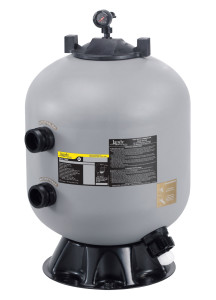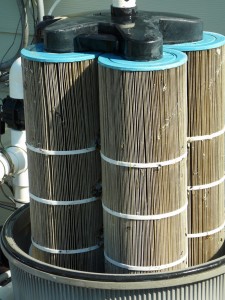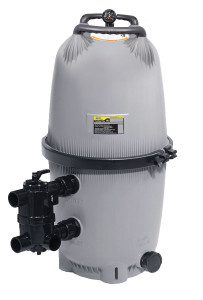A filters job is to trap all of the fine dust, dirt, sand, particulates and organics that are in your pool water, creating inviting crystal clear water. Your filter won’t purify your water—that’s the job of chlorine. Filter efficiency is measured by its ability to filter out these small particles, measured in microns (1/1000 of a millimeter). For reference, a grain of salt is about 100 microns, and the human eye can see as small as 35 microns without magnification. A sand filter is the least efficient at removing smaller particles, followed by the cartridge filter and the most efficient, a D.E. filter. Sand filters can remove particles as small as 20-50 microns, Cartridge filters 10-20 microns, and D.E. 1-3 microns. Variable speed pumps help to maximize the effectiveness of a filter, as low velocity gives optimum filtration.
Sand Filters
 Sand filters are nice in desert areas where you have to frequently backwash the filter because of continual dust. But in times of drought, this is a waste of a scarce natural resource, not to mention the chemicals that you are “washing away”. (This same challenge exists with D.E. filters.) On the positive side, sand filters are virtually maintenance free, and can go for years by merely backwashing. Sand can last for up to 10 years. Because a sand filter can’t get the smaller particles, pool water can start to look cloudy over time. Adding a water clarifier will gather all the small particles and join them together into larger pieces that can get filtered out.
Sand filters are nice in desert areas where you have to frequently backwash the filter because of continual dust. But in times of drought, this is a waste of a scarce natural resource, not to mention the chemicals that you are “washing away”. (This same challenge exists with D.E. filters.) On the positive side, sand filters are virtually maintenance free, and can go for years by merely backwashing. Sand can last for up to 10 years. Because a sand filter can’t get the smaller particles, pool water can start to look cloudy over time. Adding a water clarifier will gather all the small particles and join them together into larger pieces that can get filtered out.
When you backwash, you run the water backwards through the filter so that all the particles trapped rise to the top of the filter and out the backwash line. Backwashing a sand filter is a two step process. First, open your backwash valve and run your filter until the water turns clear. Then, let the filter to sit for 30 seconds to allow the sand to settle down and re-trap the dirt. Then set the backwash valve to rinse until the water runs clear. This prevents the small amount of dirt to return to the pool after backwashing.
Sand filters add the most resistance to a pool plumbing system. Moving water through the sand requires high pressure. This makes a sand filter the least effective of the three for infloor cleaning systems.
Cartridge Filters
Many cities and HOA’s have banned backwashing into storm drains. In these cases, water must be discharged into your yard. If your yard can’t hold the water, then a Cartridge filter is your best option. Cartridge filters are much easier to maintain than D.E. filters, since you don’t have to backwash. You do need to clean them a couple times a year, indicated by the water pressure. They are especially effective in pools with relatively small bather loads.
Cartridge filters are the most energy efficient of the three. Because they have the greatest square footage of filtration area, there is a larger area to move water through. Moreover, as dirt accumulates inside the cartridges, resistance increases at a slower rate, because it is blocking a lower measurable percentage of filter area. Cartridge filters become more efficient over cleaning cycles, as the pores of the cartridge become covered by larger particles, thus filtering out finer particles. Thus the rating of 10 to 20 microns. 20 microns initially, and 10 microns towards the end of a cleaning cycle.
 It is OK to oversize a cartridge filter, so I recommend a large capacity cartridge filter for two reasons: you lengthen the time between cleanings and you see a small energy savings with reduced resistance. Cartridge filters need to be thoroughly cleaned with high pressure water and soaked in a mild acid-water solution to remove calcium buildup, stubborn particles and invisible bacteria that have clogged the micro pores. Cartridges could also be soaked in a mild solution of TSP to remove oils, if that is an issue in your pool. Be careful not to damage the bands of the cartridge when using high pressure to clean between the pleats. Cartridges need to be replaced every few years. Crooked, buckled or torn pleats are signs that the cartridge is getting old and needs to be replaced.
It is OK to oversize a cartridge filter, so I recommend a large capacity cartridge filter for two reasons: you lengthen the time between cleanings and you see a small energy savings with reduced resistance. Cartridge filters need to be thoroughly cleaned with high pressure water and soaked in a mild acid-water solution to remove calcium buildup, stubborn particles and invisible bacteria that have clogged the micro pores. Cartridges could also be soaked in a mild solution of TSP to remove oils, if that is an issue in your pool. Be careful not to damage the bands of the cartridge when using high pressure to clean between the pleats. Cartridges need to be replaced every few years. Crooked, buckled or torn pleats are signs that the cartridge is getting old and needs to be replaced.
D.E. Filters
Diatomaceous Earth (D.E.) filters are best suited for pools with high use, and where clear water is a priority. D.E. is a white powder that when observed under a microscope has many pores that can trap the smallest particulates. D.E. comes from the fossilized skeletal remains of tiny sea creatures called diatoms.
In the day time when the sun is shining, most people can’t tell the difference between water filtered with a D.E. filter versus a cartridge filter. When you notice a difference is when you are swimming with goggles and you see the floating particles, or at night, with the water calm and the light on, you see the suspended particles.
 Water clarity comes at a price. D.E. filters require the most time and effort to service and maintain. A D.E. filter can be partially cleaned by backwashing. Every time you backwash, you have to recharge the filter by adding additional D.E. powder. Because backwashing does not remove all of the caked dirt, debris and leftover D.E., the filter needs to be cleaned 1-2 times per year to remove caked D.E., just as you would a cartridge filter. Every care should be taken so you don’t inhale D.E. when working with it.
Water clarity comes at a price. D.E. filters require the most time and effort to service and maintain. A D.E. filter can be partially cleaned by backwashing. Every time you backwash, you have to recharge the filter by adding additional D.E. powder. Because backwashing does not remove all of the caked dirt, debris and leftover D.E., the filter needs to be cleaned 1-2 times per year to remove caked D.E., just as you would a cartridge filter. Every care should be taken so you don’t inhale D.E. when working with it.
